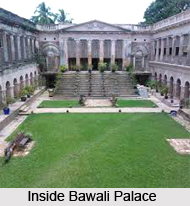 Tourism in Bawali deals with the Palace of Bawali, which is now converted into a heritage hotel in Budge Budge, some ancient Hindu temples of late medieval and colonial era, Garden of architectural excellence, Pujali, Budge Budge Ferry Ghar, Raypur and many others.
Tourism in Bawali deals with the Palace of Bawali, which is now converted into a heritage hotel in Budge Budge, some ancient Hindu temples of late medieval and colonial era, Garden of architectural excellence, Pujali, Budge Budge Ferry Ghar, Raypur and many others.
Bawali is a rural community settlement near the industrial town of Budge-Budge in South 24 Parganas District of West Bengal. Bawali, the semi urban town in Budge Budge came into existence during the rule of Mughal Emperor, Akbar.
Palace of Bawali
Bawali is the place of architectural and cultural excellence. Here one can find the lost glory that blushes from the ruined walls and the Corinthian pillars of Greco- Roman architecture. The greatest attraction of Bawali is the 300 year-old Bawali Raajbari (Palace of Bawali). Palace of Bawali or Bawali Rajbari was erected in the later phase of medieval time that is during the rule of Akbar, the Mughal Emperor. Bawali Rajbari is closely associated with the military life and personal life of Mondal royal family. The antique furniture, the morning walk in the complex of Rajbari, the ancient Corinthian pillars are a treat to a history lover.
Navratna Gopinath Temple
Navratna Gopinath Temple was built during the same time, while the Bawali Rajbari was erected. It is believed that Rani Rashmoni built the famous Dakshineshwar Temple, in the later phase of eighteenth century, inspired from the architecture of this temple in Bawali. A visit to the ruins of Navratna Gopinath Temple and its adjacent temples will be a nice experience for a weekend escaper.
 Ferry Ghat of Budge Budge
Ferry Ghat of Budge Budge
Ferry Ghat of Budge Budge has the modern historical significance. Ferry Ghat of Budge Budge greeted Swami Vivekananda in 1897 when he returned from his Chicago visit. Till date, this event is celebrated by the people of Budge Budge on February 19 every year.
Raypur
Raypur is a census town under Budge Budge police station of Alipore subdivision in South 24 Parganas district in West Bengal. A visit to Raypur riverside is breathtaking and the calm atmosphere is attracted by the nature lovers and the professional and amateur third eyes. Raypur is just 7 kms away from the Palace of Bawali.
Achipur
A trip to Achipur will be perfect weekend for a traveller, who finds the traditional Chinese dishes. One will find a Chinese Temple here still holding back its wood carvings and a grand entrance. Achipur was a Chinese settlement founded by the Chinese businessman, Tong Achi in the early phase of British Colonial era, who established a sugar mill here during the 1770 when Warren Hastings was the Governor-General of Bengal. One can also see the cenotaph of Tong Achi, showing the grand architectural designs of Chinese traditions.
Boro Kachari Mandir
Boro Kachari Mandir is a famous temple in Bawali. It is around 6 kms. One will find the ruin of the ammunition depot of the British army, which is just located just beside the river, is worth a visit.



















